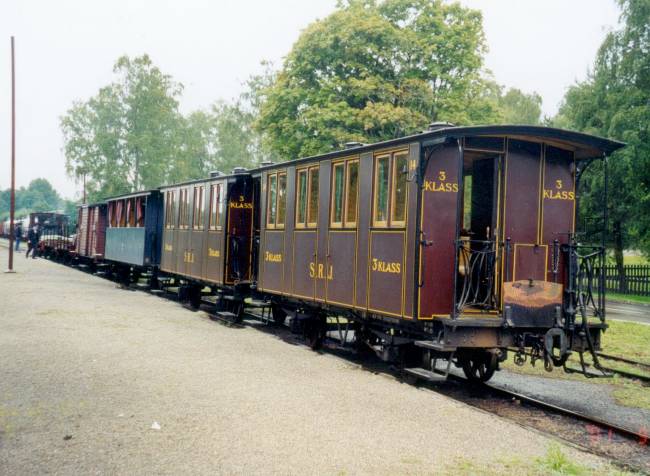Stockholm-Roslagens Järnvägar, SRJ

Some of the very first four wheel open platform passenger coaches of SRJ - built 1885 - are still in operation at the preserved line ULJ. Photo and © Per Nilsson.
Roslagsbanan, or Stockholm-Roslagens Järnvägar (SRJ) ,was one of the largest narrow gauge railway networks in Sweden. It later expanded into a 327 km big three foot (891 mm) empire north of Stockholm. It also included Dannemora - Hargs Järnväg, DHJ, in the north of the province Uppland. See maps!The source of the
following information is mainly "Roslagsbanan 100 år" published
in
1985 by AB Storstockholms Lokaltrafiks Järnvägar, ISBN
91-7266-087-2.
The Early Years
The first line to be opened of what later would become Stockholm-Roslagens Järnvägar was Uppsala-Länna Järnväg, ULJ. From 1876 it connected Länna and its ironworks with blast-furnance with the university town of Uppsala were the 20,5 km long line met the standard gauge line of SJ.The next line to be opened (in 1878) was also created to support the iron industry. Dannemora-Hargs Järnväg, DHJ, connected the big open iron mine in Dannemora with the ironworks in Gimo and the deep water harbour in Harg, totally 39 km. Timber became a good source of revenue in addition to the iron ore, charcoal and iron products, but passenger traffic was scarce, in the beginning only one train in each direction on weekdays, none on Sundays!
By 1884 the
Uppsala-Länna
line was extended with a new railway - Länna-Norrtälje
Järnväg,
LNJ. This 60 km long line connected the town of Norrtälje,
situated
at a well protected harbor in the middle of the Roslagen coast line,
with
Uppsala and the rest of the swedish railway network. ULJ and LNJ
immediately
started to co-operate with one through passenger train a day in each
direction
between Uppsala and Norrtälje. The first time table of 3 hours 40
minutes for a one way trip, was soon extended to 4 hours and 18 minutes
for the 80 km!!!
Stockholm - Rimbo Järnväg
By 1885 it was time to open the 55 km of Stockholm - Rimbo Järnväg, SRJ, which was to become the mainline of Roslagsbanan. It connected Stockholm with the rich country side north of the capital, and with Rimbo - the junction with Länna-Norrtälje Järnväg. This created a three foot connection between Stockholm and Uppsala respective Stockholm and Norrtälje.Except for acting as a supply line for Stockholm, feeding the city with agricultural products and wood, SRJ carried a fairly high number of passengers. The first narrow gauge commuter line north of Stockholm was born.
Additional
commuter
traffic was added when Djursholmsbanan, DjB, was opened in 1890.
Djursholm
expanded as a popular new area where the prosperous people could build
their own houses at big lots in the "Garden Village". With
Djursholmsbanan
they could commute to and from the city. However, the little train did
pollute the "Garden Village", and soon plans were made to convert the
line
to electric operation...
|
|